10 Best Shared Inbox Tools Reviewed: Which One Is Right for You?
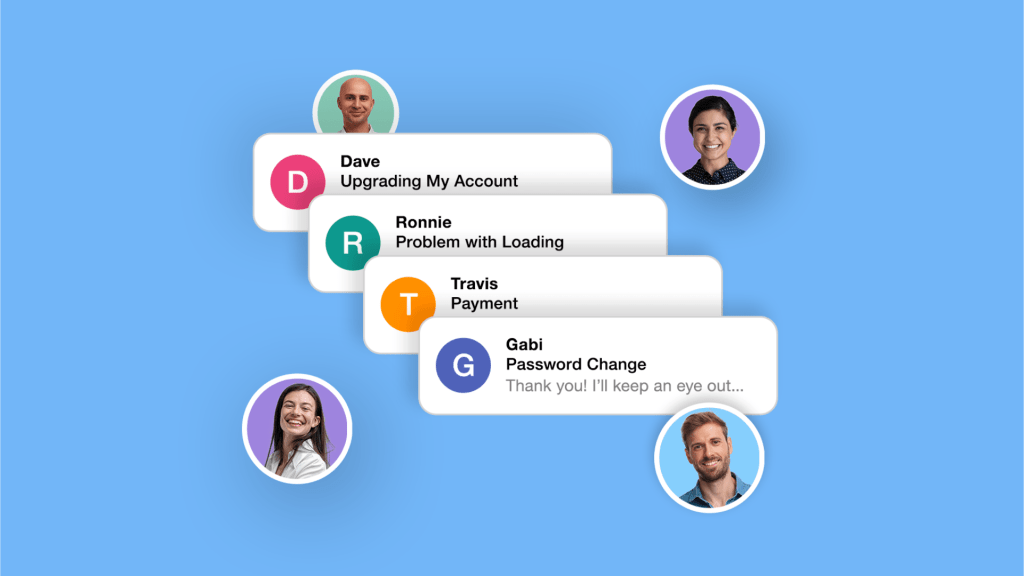
Imagine your team’s customer support communications flowing seamlessly—every message assigned to the right person, every response delivered with lightning speed, and zero confusion over who’s handling what.
A shared inbox makes that vision a reality, allowing teams to provide standout support and build lasting customer relationships without email bottlenecks.
If you’re considering a shared inbox, you already know how crucial it is to deliver fast, efficient, consistent responses across your team. Shared inbox software empowers support, sales, and operations teams to work together, respond faster, and stay perfectly in sync.
But with so many options available, which shared inbox tool will deliver the best results for your team? You’re in the right place.
In this article, we’ve handpicked the top shared inbox solutions for 2024—tools designed to transform your team’s communication, boost productivity, and ensure flawless customer interaction. Let’s dive in and find the perfect shared inbox for your needs.
What is a Shared Inbox?
A shared inbox is a collaborative email management tool designed to empower teams by compiling all communication. Think of it like a single email address—support@ or sales@—that can be accessed, viewed, and responded to by multiple team members with full visibility into who’s handling each message.
The power of a shared inbox is more than just what supports and team workflows get eased up. Customer support teams can tell in one glance which emails need attention and who’s managing which query, and can add internal notes to make sure follow-ups are seamless.
Sales teams can also use shared inboxes to track inquiries, distribute responses, and ensure no opportunity slips through the cracks. Shared inboxes bring transparency to team communications and allow accountability, thus enabling quicker and more effective unified reactions that can lead to happier customers and more productive teams.
Shared Inbox Key Features
Choosing the right shared inbox tool is critical for enhancing team efficiency and delivering exceptional customer support. But with so many available options, how do you know which features matter?
We’ve got you covered. Below are the must-have features that any robust shared inbox software should offer—ensuring your team operates efficiently, your communications stay seamless, and every customer gets the response they deserve.
-
Group Email Management
Managing team emails effectively requires tools to categorize, assign, and track messages across your team. A great shared inbox allows everyone to see the workflow and status of each customer interaction, ensuring that no email goes unanswered or falls through the cracks.
-
Read Tracking
Read tracking is crucial for visibility. With this feature, team members can instantly see which emails have already been viewed or handled, avoiding duplicate replies and ensuring quick, coordinated responses.
-
Collision Detection
The last thing your team needs is multiple people responding to the same email. Collision detection prevents overlap by alerting team members when someone is already handling a conversation. This keeps your communications efficient and avoids any confusion or mixed messages.
-
In-Conversation Comments & Notes
Clear communication continues beyond email replies. Leaving internal comments and notes within email threads makes it easier for your team to track individual contributions, provide context for complex issues, and collaborate on the best way to respond—all without leaving the shared inbox.
-
Status Notes
Keeping track of where each email stands can be a game-changer. A shared inbox should let you set statuses like “To Do,” “In Progress,” “Pending,” “Done,” or “Closed.” At a glance, anyone on your team can identify which messages need action, which are being addressed, and which are resolved, providing clarity across all communications.
-
Admin Control & Permissions
Your shared inbox should empower your team without compromising on security or organization. With admin controls, you can set user permissions, monitor activity, and manage access to different inboxes. This ensures that the right team members have access to every conversation.
-
Generative AI Responses
In a fast-paced world, speed and efficiency are critical. Generative AI responses use advanced language models to suggest or automate replies to common inquiries. This reduces response times and lightens your team’s workload, allowing them to focus on more complex customer needs.
Ensuring your shared inbox software has these key features will enable your team to work smarter, respond faster, and create a seamless customer experience.
The 10 Best Shared Inbox Software Options
Here are 10 team inbox tools that can help any team provide better email support.
1. Spike
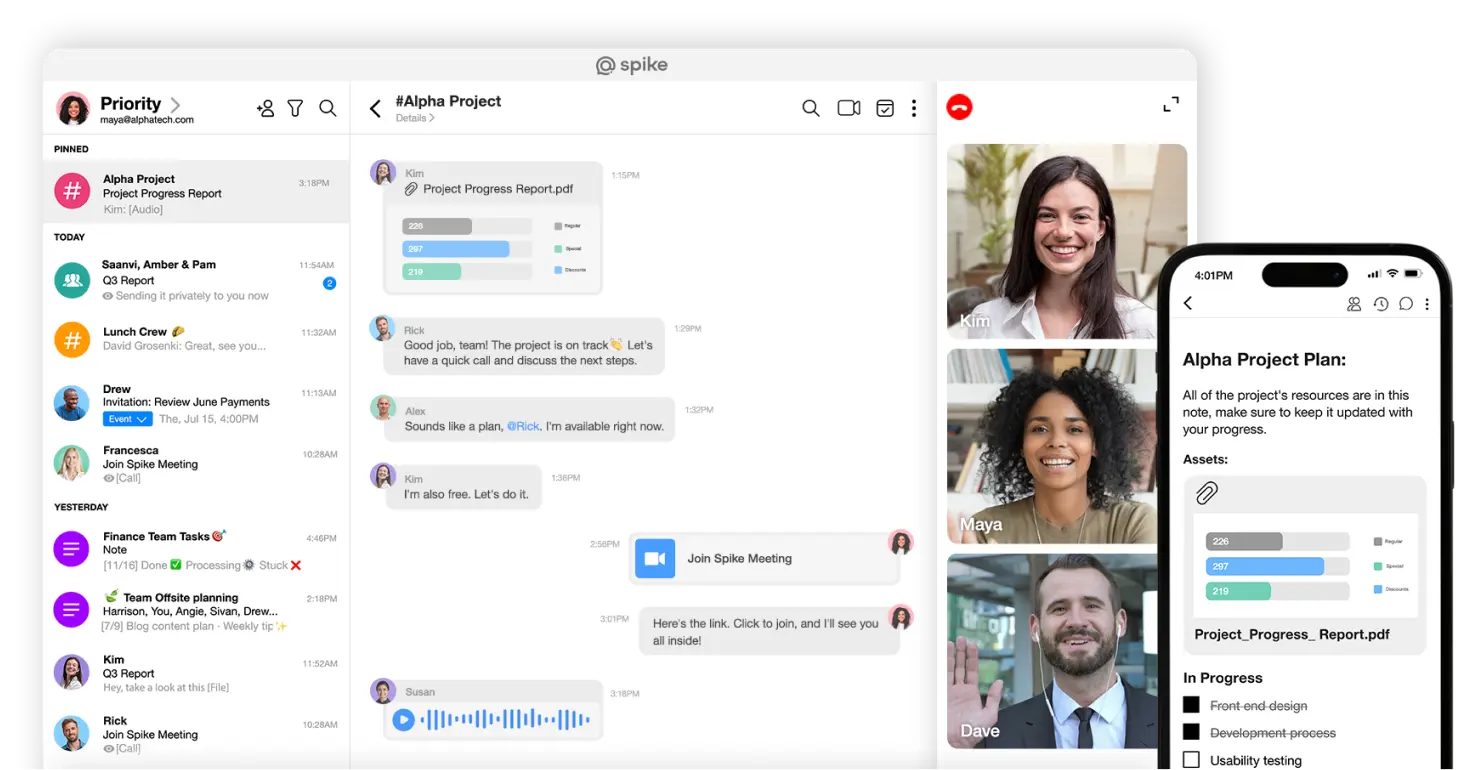
Best for: Teams looking to streamline support and internal communication with a conversational email approach.
Spike transforms how teams handle email by turning messages into a chat-like flow, making managing, responding, and collaborating easier and faster. Built to enhance productivity, Spike integrates email, team chat, tasks, and collaboration into one unified platform. So your team can work together without bouncing between apps.
Why Spike Stands Out:
Spike’s shared inbox offers real-time visibility into team emails, allowing you to assign messages, track their status, and respond as a team—all within the same thread. Unlike traditional email clients, Spike’s conversational view lets you see email threads like chat messages, making reading and responding quicker. It also helps teams communicate naturally and efficiently.
Key Features:
- Shared Inbox with Teamspace Permissions: Grant each team member the right level of access so the right people can handle specific emails without confusion.
- Advanced Email Status Tracking: Set the status of any email to “To Do,” “In Progress,” “Pending,” “Done,” or “Closed” for complete visibility into what needs action and what’s already resolved.
- Magic AI: Spike’s built-in AI helps you compose replies faster, suggest responses, and draft messages to improve response times without compromising on quality.
- Integrated Collaboration Tools: Shared notes, comments, and tasks make it easy for your team to add context, assign responsibilities, and collaborate without leaving the inbox.
- Enhanced Search Capabilities: Quickly find any message, contact, or file with Spike’s advanced search—no more digging through your inbox.
Why Choose Spike?
Spike isn’t just a shared inbox; it’s a complete communication platform designed to help teams stay connected, manage customer inquiries effectively, and maintain top-notch internal coordination.
By blending email and team chat, Spike enables you to deliver quick, personalized support and makes internal communication effortless.
Pricing:
Spike offers a free version with essential features, while paid plans with more advanced capabilities start at just $4 per monthly user.
Try Spike for Free and experience a better way to manage your team’s shared inbox today.
2. Front
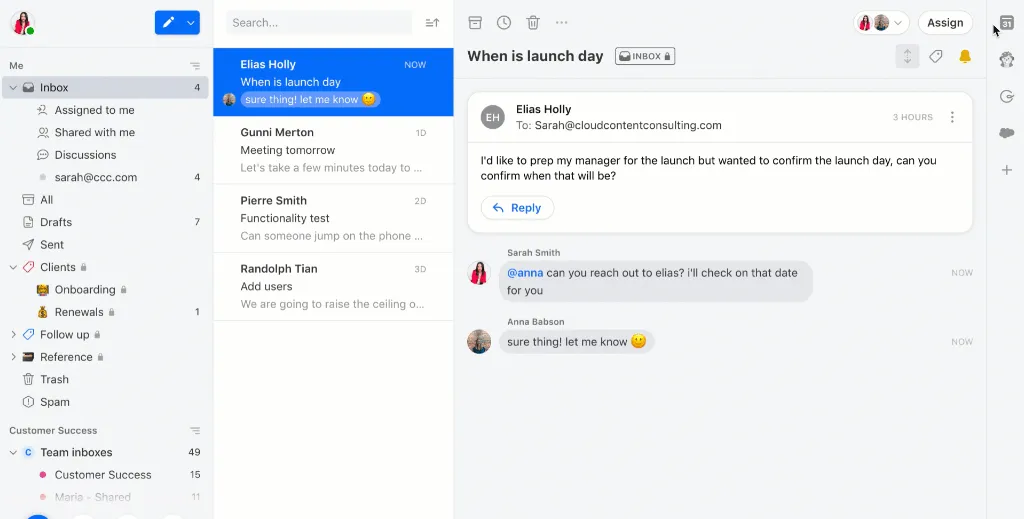
Best for: Teams needing multi-channel communication management with a personal touch for support and sales inquiries.
Front helps teams collaborate on emails, social media messages, and other communications—all within a single platform. Unlike most shared inbox solutions, Front enables team inboxes and personal email addresses to be managed in one place, making it suitable for teams that need a blend of shared and private communications.
Key Features:
- Multi-Channel Communication: Manage emails, social media messages, SMS, and live chat in a single interface so your team never misses a message.
- Internal Collaboration Tools: Leave comments, share drafts, and assign tasks directly within each message thread, making team collaboration easy and organized.
- Collision Detection: Provides clear indicators when a team member is already handling a conversation to avoid duplicate responses.
- Automation and Workflows: Create rules to automate routine tasks like email assignments or tagging, improving workflow consistency.
- Analytics & Reporting: Access insights into response times, team performance, and communication trends.
Pricing:
Front offers a free trial, with paid monthly plans starting at $19/seat.
3. Missive
Best for: Teams handling multiple communication channels who want a unified email, SMS, and social media inbox.
Missive combines email, SMS, and social media management into a single platform, allowing teams to handle all their external communications from one place. Designed to promote efficient collaboration, it offers shared inbox features alongside integrated task management and chat functionalities for seamless team discussions.
Key Features:
- Unified Inbox: Consolidate email, SMS, and social media messages into a single interface for easy, centralized management.
- In-Conversation Comments & Chat: Collaborate directly within each thread by leaving comments and chatting with team members to discuss the context and next steps without leaving the inbox.
- Task Assignment & Tracking: Assign messages as tasks to individual team members, track their progress, and stay aligned on responsibilities.
- Email Snoozing & Scheduling: Snooze emails to revisit them later or schedule responses for optimal delivery times.
- Integration with Third-Party Apps: Missive connects with various productivity tools and apps to streamline your team’s workflow.
Pricing:
Missive offers a free plan with limited features, while paid plans start at $14/user per month and offer access to advanced functionalities.
4. Hiver
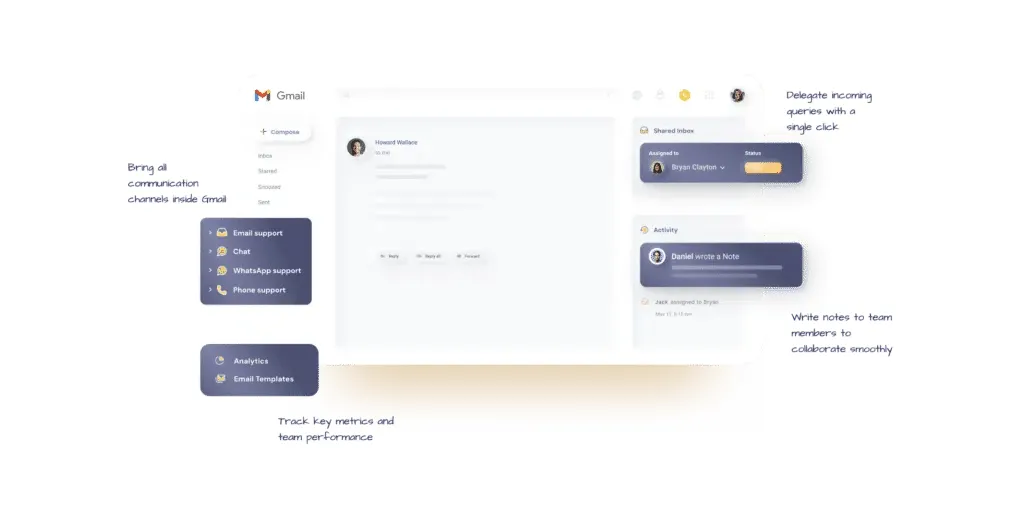
Best for: Teams that want to manage shared inboxes directly within Gmail without switching platforms.
Hiver is designed for teams already using Gmail who need more robust email management capabilities. As a Gmail add-on, Hiver enhances the standard Gmail interface, allowing teams to manage shared inboxes like support@ or sales@ without learning a new platform.
Key Features:
- Gmail Integration: Seamlessly integrates with Gmail, so your team can use shared inbox features without leaving their familiar interface.
- Email Assignment: Assign emails to specific team members for accountability, ensuring every inquiry is owned by the right person.
- Collision Alerts: Prevents multiple team members from responding to the same email by providing visual indicators if someone else is handling the conversation.
- Email Tags & Categorization: Organize your inbox with tags to easily categorize messages and filter conversations for efficient sorting.
- Analytics & Reporting: Track team performance, response times, and other metrics directly from your Gmail interface.
Pricing:
Hiver offers a free trial, with paid monthly plans starting at $19/user for teams that need advanced shared inbox features.
5. Help Scout
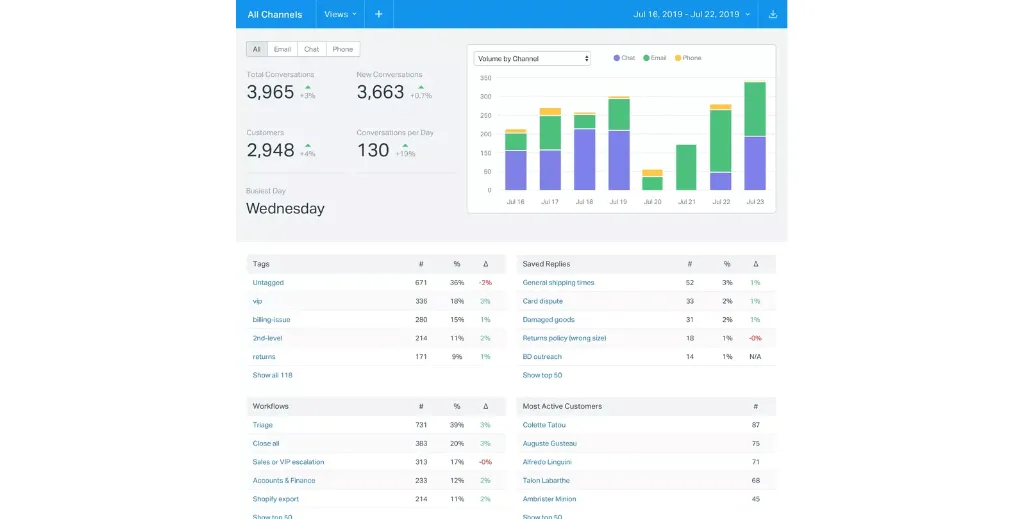
Best for: Customer support teams needing a shared inbox solution with multi-channel support and self-service capabilities.
Help Scout is more than a shared inbox—it’s a customer support platform designed to help teams provide efficient, personalized support at scale. With features like private notes, assignments, and collision detection, Help Scout allows teams to manage customer inquiries across different channels, including email, live chat, and a knowledge base.
Key Features:
- Shared Inbox for Support Teams: Manage customer inquiries across channels with tools to assign conversations, add notes, and track progress.
- Collision Detection & Private Notes: Avoid duplicate responses with collision detection and collaborate privately within each email thread.
- Automated Workflows: Use tags, custom views, and workflows to automate email routing and categorization for faster response times.
- Knowledge Base Integration: Create and maintain a knowledge base for self-service, directly connected to your shared inbox for quick reference.
- AI-Powered Tools: Leverage AI to draft and refine replies, create conversation summaries, and suggest responses for faster support.
Pricing:
Help Scout offers a free trial; paid plans start at $22/user per month.
6. Zendesk
Best for: Scalable customer support and service teams looking for a comprehensive tool with shared inbox capabilities.
Zendesk offers many tools for managing customer support, including a shared inbox, live chat, and phone support. Designed to support growing businesses, it provides a robust platform for managing high volumes of customer interactions while offering automation and workflow customization to improve efficiency.
Key Features:
- Shared Inbox with Multi-Channel Support: Centralize all customer inquiries from email, chat, and other channels in one place.
- Advanced Automation: Utilize automation for tagging, email assignment, and prioritizing tickets, saving time on repetitive tasks.
- Customizable Workflows & Views: Create custom views for your team to organize and monitor open cases by status, priority, or assignee.
- Analytics & Reporting: Track response times, customer satisfaction, and team performance.
- Integrations & Scalability: Connect Zendesk to other business tools and customize it to scale with your support team’s needs.
Pricing:
Zendesk offers a free trial, and paid plans for its support features start at $19 per month.
7. Freshdesk
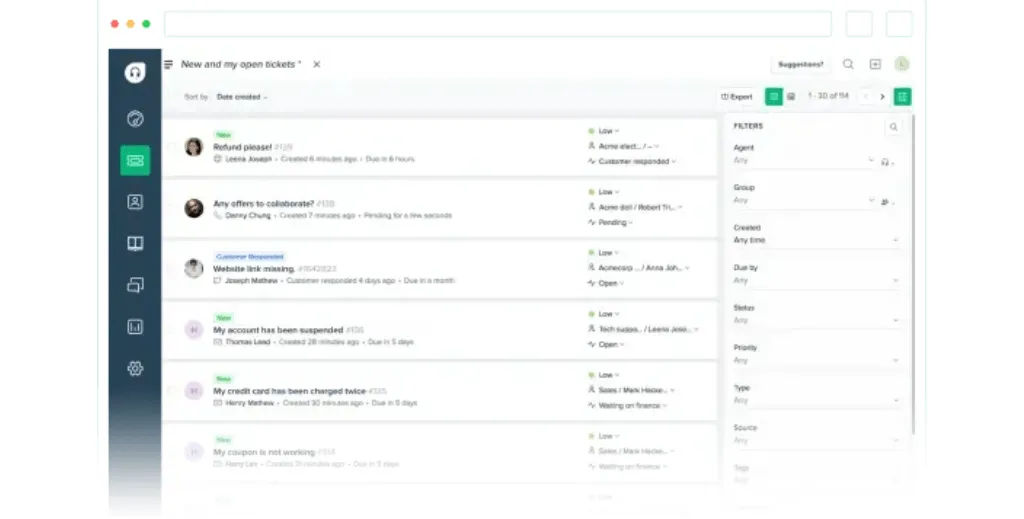
Best for: Teams looking for a user-friendly shared inbox tool with ticketing capabilities and multi-channel support.
Freshdesk is a customer support solution with a shared inbox feature within its broader help desk platform. Designed for simplicity and ease of use, Freshdesk allows teams to manage all customer communications through a single dashboard while offering ticketing, automation, and collaboration tools to improve response times and efficiency.
Key Features:
- Shared Inbox with Ticketing System: Convert customer emails into tickets that can be assigned, tracked, and managed within one platform.
- Collision Detection & Internal Notes: Prevent duplicate responses and use internal notes for private team collaboration within a ticket.
- SLA Management & Automation: Set service level agreements to ensure timely responses and use workflow automation to route tickets and assign priorities.
- Multi-Channel Support: Manage inquiries from email, live chat, phone, and social media—all from a centralized inbox.
- Event-Triggered Automation: Automate repetitive tasks like sending canned responses or updating ticket statuses based on specific triggers.
Pricing:
Freshdesk offers a free plan for small teams, and paid plans with additional features and advanced capabilities start at $15/agent per month.
8. Zoho Mail
Best for: Teams already using Zoho’s suite of business tools and seeking an integrated shared inbox solution.
Zoho TeamInbox is part of the Zoho ecosystem, offering shared inbox capabilities focusing on collaboration and productivity. Built to help teams manage email conversations efficiently, it provides tools to assign messages, add comments, and track progress, all while integrating seamlessly with other Zoho applications.
Key Features:
- Centralized Team Inbox: Manage all your team’s shared email addresses in one place, with options to delegate emails, tag conversations, and monitor status.
- Thread-Level Collaboration: Collaborate with your team using comments, mentions, and shared drafts to finalize responses before sending.
- Snooze & Email Statuses: Use the snooze function to revisit emails later and set custom statuses to track progress on each thread.
- Rule-Based Automation: Automate repetitive tasks like tagging and routing emails based on certain conditions to improve workflow efficiency.
- Zoho Ecosystem Integration: Seamlessly integrate with other Zoho apps (e.g., CRM, Desk) for a unified business management experience.
Pricing:
Zoho TeamInbox offers a free trial, and paid plans with more advanced functionality and integrations start at $1 per monthly user.
9. ProtonMail
Best for: Teams prioritizing privacy and data security in their shared inbox communications.
ProtonMail is a secure email service that protects your team’s communications with end-to-end encryption. While not a traditional shared inbox tool, it allows teams to create email aliases that can be used as shared addresses, providing an added layer of privacy and security for sensitive communications. This makes it suitable for teams handling confidential information or operating in privacy-sensitive industries.
Key Features:
- End-to-End Encryption: All emails sent and received through ProtonMail are fully encrypted, ensuring complete data privacy.
- Shared Aliases for Team Access: Create and manage shared email aliases to centralize messages while keeping communication secure.
- Self-Destructing Emails: Send emails that automatically delete after a specific time, adding another layer of privacy for sensitive information.
- Two-Factor Authentication: Enhance security with two-factor authentication for all team inboxes, reducing the risk of unauthorized access.
- Minimal Data Logging: ProtonMail’s infrastructure is designed to minimize data logging, making it suitable for teams that need high confidentiality.
Pricing:
ProtonMail offers free plans with basic features, while paid plans start at $9.99/user per month for additional storage, domains, and advanced security features.
10. Outlook’s Shared Mailbox
Best for: Small teams already using Microsoft 365 who need basic shared inbox functionality without added costs.
For teams already operating within the Microsoft ecosystem, the Outlook shared mailbox is a simple solution to managing shared emails. It enables multiple team members to access a shared inbox, read messages, and respond as needed without additional logins. While it may not have the advanced features of dedicated shared inbox tools, it integrates seamlessly with Microsoft 365 applications.
Key Features:
- Direct Integration with Microsoft 365: Set up a shared mailbox within your existing Outlook and Microsoft 365 environment.
- Basic Shared Inbox Functionality: Share access to familiar email addresses, manage incoming emails collectively, and monitor who handles each conversation.
- Familiar Interface: Use Outlook’s familiar interface to manage shared email communications without learning a new tool.
- Categorization & Sorting: To organize your shared inbox effectively, use standard Outlook features like categories, folders, and flags.
- User Permissions & Access Control: Set permissions for each user to ensure the right team members can view and respond to shared emails.
Pricing:
The Outlook shared mailbox is free to Microsoft 365 users, and Microsoft 365 business plans start at $6.99/user per month.
Wrapping Up
Choosing the right shared inbox tool is vital for boosting team collaboration, streamlining customer communications, and enhancing productivity.
Each tool covered in this roundup offers unique features suited to different needs—whether you’re looking for seamless integration with existing platforms like Gmail or Outlook, multi-channel communication capabilities, or even advanced AI-powered functionalities.
However, if you’re seeking an all-in-one communication platform that transforms email into a chat-like experience and seamlessly integrates team collaboration, Spike is a standout choice.
With its blend of shared inbox capabilities, internal collaboration tools, and advanced AI features, Spike provides an intuitive, efficient way to keep your team connected and responsive.
Ready to Take Your Team’s Email Management to the Next Level?
Try Spike for Free and experience how a shared inbox can revolutionize your team’s communication and productivity.




